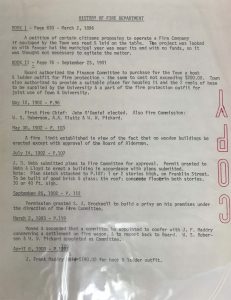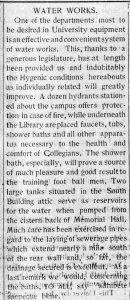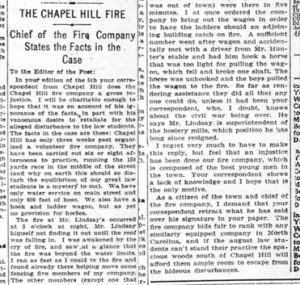The Chapel Hill Fire Department was established in 1896. Everybody knows that, right? Says so on their emblem. But what happens when historical records suggest, perhaps, something different? Let’s a look.
Our story begins with a “visiting professor.” Enter local fire historian and CHFD friend Mike Legeros.
Starting in late spring, he commenced a deep dive into Chapel Hill fire history. He connected with the department historian (and his retired predecessor) and began an exploration, an expansion, a review, an audit, of their written history.
That is, everything about their past in find-able written form.
Town Minutes Excerpts
In the CHFD archives was a typed copy of town minutes, excerpted from 1896 to 1922. (Which you can read here.) They’d been transcribed by someone, some years or decades prior. And they’re some of the oldest municipal records about the department. Click to enlarge:
The first part of the first page reads:
BOOK I – Page 630 – March 2, 1896
A petition of certain citizens proposed to operate a Fire Company if equipped by the Town was read & laid on the table. The project was looked on with favour but the municipal year was near its end with no funds, so it was thought not necessary to agitate the matter.
BOOK II – Page 76 – September 23, 1901
Board authorized the Finance Committee to purchase for the town a hook & ladder outfit for fire protection – the same to cost not exceeding $200.00. Town also authorized to provide a suitable place for housing it and the 2 reels of hose to be supplied by the University & a part of the fire protection outfit for joint use of Town & University.
May 12, 1902 – P.96
First Fire Chief: John O’Daniel elected. Also Fire Commission: W. S. Roberson, A.A. Kluttz & W. W. Pickard.
May 30, 1902 – P. 103
A fire limit established in view of the fact that no wooden buildings be erected except with approval of the Board of Aldermen.
Etc.
The minutes continue with references to the fire commission conducting construction plans review (1902), acquiring a “fire wagon” (1903), electing a salaried fire chief (1903), finding a firehouse (1903), and so on.
Petition of Certain Citizens
Observe the first entry, from 1896:
A petition of certain citizens proposed to operate a Fire Company if equipped by the Town was read & laid on the table. The project was looked on with favour but the municipal year was near its end with no funds, so it was thought not necessary to agitate the matter.
Legeros interprets as follows:
- Town residents were interested in creating a volunteer fire company.
- They wanted the town to provide the fire equipment.
- The town liked the looks of the proposal.
- But the municipal year was nearly over and the town’s funds for the year were nearly exhausted.
- The town declined to take action.
Then what happened? Good question!
The town minutes didn’t record another action on fire protection until five years later. That’s when the town board authorized the purchase of a “hook and ladder outfit” in 1901. They also authorized finding a place to house the truck, and a pair of hose reels that the University would provide. The truck and the reels would be available for joint protection of the town and the college.
Combining these two entries gives the following:
- 1896 – Citizens ask town council about forming a volunteer fire company, with town-provided equipment. Town declines to act.
- 1901 – Town authorizes purchase of fire equipment, and finding a place to house. Will be combined with university-provided equipment, and all used for joint protection of town and college.
So what was happening between those years? Was any fire protection in place in town?
Waterworks Installed, 1893
The next piece of the puzzle was uncovered in the Daily Tar Heel digital archives. They have 100 years of their paper available online and searchable. And Legeros found this in a story on September 15, 1893:
Waterworks installed at university. Includes a dozen fire hydrants around campus.
That’s paraphrased. Here’s the complete story, click to enlarge:
Legeros thus interprets as this as happened:
The first fire hydrants on campus were installed by September 1893. Subsequent hydrants were installed in town, also part of the University-operated system. How soon? Unsure. But by 1901, the University had (or was prepared to obtain) hose reels, which carried the hose, which was connected to the hydrants, which was used for fighting fire. (No hand- or steam- or motor-pumping fire engine required.)
Were hydrants installed in town by 1896? Was that action what precipitated some citizens to petition the town? Or were thinking of forming a “bucket and ladder” company. No hose, no nozzles. Just ladders and tools and a bucket brigade for fighting fire? Good question.
What do those town minutes tell us?
- 1901 – Two reels of hose to be supplied by the University, for joint use of town and school. Doesn’t reference fire hydrants. Perhaps there were hydrants on campus, but close enough to the business district, to provide fire protection? Need to find an old water system map!
- 1904 – Fire Chief instructed to “secure prices of reel and hose”. Okay, this gets us closer. If the town is looking to buy a hose and reel, there are probably hydrants inside the town limits, as well.
Letter to the Editor
The next clue was uncovered on Newspapers.com. That’s a paid service with searchable archives, and that contains numerous local papers published in the early 20th century. (Up until the public domain copyright period ends in 1927.)
In the Raleigh newspaper the Morning Post, August 6, 1903, appeared a letter from the Chapel Hill Fire Chief. Click to enlarge:
He was correcting the paper’s account of a recent fire, and the company’s performance therein. Most notable is this sentence:
Chapel Hill has only three weeks past organized a volunteer fire company.
Wait, what? Two more sentences are also useful:
We have only water service on main street and only 600 feet of hose. We also have a hook and ladder wagon, but no provision for horses.
Okay, so by August 1903, there were fire hydrants on Main Street. The fire department has hose, ladders, and a wagon for transporting. (Did they also have a hand hose reel? Or did this wagon have a hose bed? Could be.)
Let’s Go Back To The List
Back to our master list o’ facts, and expanding a bit:
- 1893, Sep – Fire hydrants installed on campus by this time.
- 1896, Mar 2 – Citizens ask town council about forming a volunteer fire company, with town-provided equipment. Town declines to act.
- 1901, Sep 23 – Town authorizes purchase of fire equipment, and finding a place to house. Will be combined with university-provided equipment, and all used for joint protection of town and college.
- 1902, May 12 – Fire Chief elected, John O’Daniel. Plus Fire Commission appointed with three people.
- 1903, Mar 2 – Buying a “fire wagon” discussed.
- 1903, Apr 6 – Bid of $190 for “hook & ladder outfit.”
- 1903, Jul 6 – Fire Chief to be elected, and with $5.00 per month salary.
- 1903, Jul 16 – Fire Chief elected, S. W. Andrews.
- 1903, Aug 6 – Volunteer fire company organized three weeks prior.
- 1903, Aug 6 – Town has fire hydrants on main street.
- 1903, Aug 6 – Town has hand-pulled hook and ladder wagon.
Does all this mean that the Chapel Hill Fire Department was established in 1903, instead of 1896?
Good question.
What Can We Conclude?
The following are solid conclusions, says Legeros:
- In 1903, a town fire company was organized.
- One and two years earlier, the town had elected a fire chief and authorized buying fire equipment.
- In case of fire, guessing a loose group of citizens would get/gather the town fire equipment, and respond. They were probably directed by the town fire chief. Maybe there was a loosely organized “group of regulars” as well.
- Perhaps also, “they tried before” to organize a formal fire company in 1901 or 1902. And we haven’t found any references. And, for whatever reason, they organized or re-organized again in 1903, as an all-new entity. (This seems unlikely. Such redos, in other towns and cities around NC, typically had longer spans of time between them.)
But what about the decade prior?
- In 1893, fire hydrants were installed on campus.
- In 1896, townspeople were interested in forming a fire company. The town declined to pursue on one recorded occasion.
- Did they try again in 1896 or 1897 or… with their efforts not recorded (or yet discovered)? Could be.
- Did the University have one or more formal fire companies of students and facility in 1893 or 1895 or 1897 or…? Could be.
- Did the town have a fire company, formal or informal, during any time between 1896 and 1903, but not (yet) found in records? Could be.
Thus the mystery.
Thus the chronological quandary.
Next Steps?
How could someone solve this one? Couple ideas come to mind:
- Compare the physical town minutes with the typed transcription of yore. Ensure nothing was missed.
- Locate every surviving newspaper issue from that period, be they digital or microfilm or even physically sitting somewhere. Look through each and every issue and each and every page. Try to find more references to early fire protection.
- Dig into personal letters or archived accounts of citizens or other historical records of the period. Maybe somebody saved a letter, describing that time period and the fire company in its beginning.
No small project, there.
Maybe in a future year, Legeros will pursue. Maybe after he’s retired. When he has some real free time.
Picking a Start Date
This story also demonstrates the tricky business of picking a department’s “start date.” But that’s another topic for another blog posting.
Signed, Legeros


